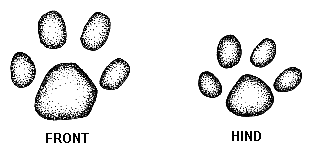
Lynx
Felus lynx
Description
- The colouring of a lynx is buff or tawny with
mixed blackish hairs and the underparts are cinnamon-brownish.
The tail is short and tipped with black; ears have long
black tufts and cheeks have long pale ruffs which form
a pointed beard at the throat. The feet are very large
and well furred. Average weight is from 10 to 40 pounds.
Distribution
- The lynx prefers the deep forest. In B.C. they occupy
most habitats but are generally absent from the coastal
region.
Biology
- Female lynx bear usually 2 kittens in May-July who
remain with her throughout their first winter. They
make their dens in hollow trees, tangled thickets and
under logs, stumps and fallen timber. Their large, thickly
furred feet allow them to stalk their prey silently
and give them better speed through soft snow where other
animals may flounder, though not the Snowshoe Hare which
is the lynx's chief prey. A chief characteristic is
their 9-10 year cycle of peaking which parallels that
of the snowshoe hare. The lynx lives as long as 12-13
years; the chief factor of death is lack of nutrition.
Man, who values its long, silky fur, the wolf and Mountain
Lion are its main predators.

Tracks - The lynx resides mainly in snowy country
and has therefore adapted to this climate. The feet
are heavily furred making the tracks appear rounded
and obscuring the toe prints. The tracks are larger
than that of a bobcat and similar to a mountain lions
although the lynx doesn't sink as deeply into the snow.
Straddle: 18 cm (7.2 in)
Stride: 30 - 36 cm (12 - 14.4 in)
Track: 10 cm (4 in) long / 10 cm (4 in) wide


